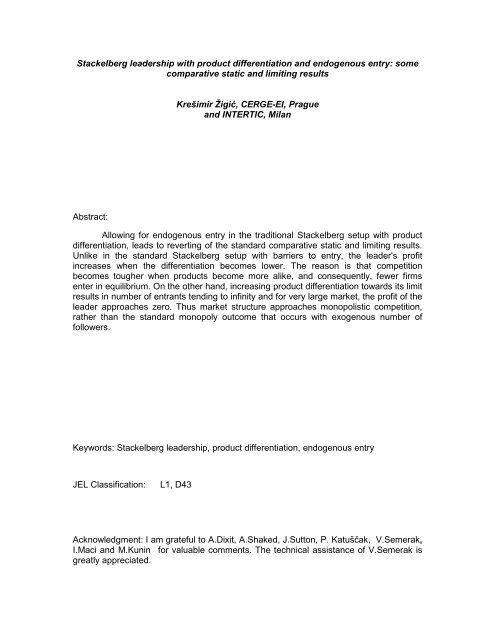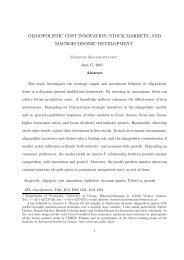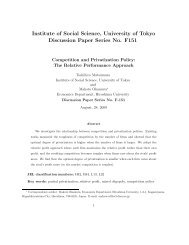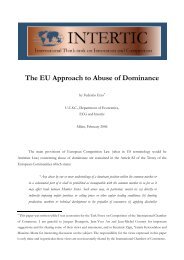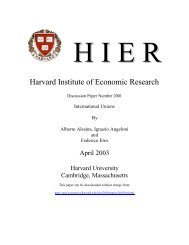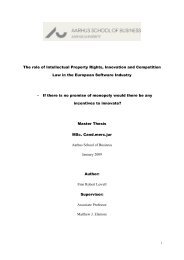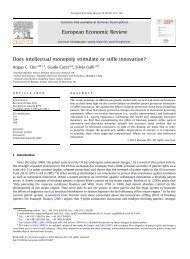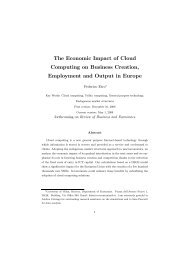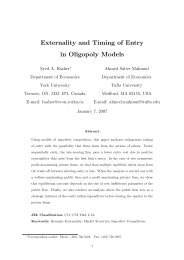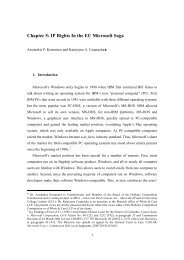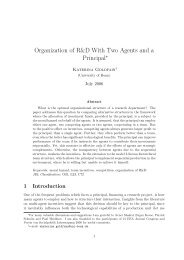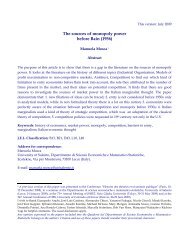Stackelberg leadership with product differentiation and ... - Intertic
Stackelberg leadership with product differentiation and ... - Intertic
Stackelberg leadership with product differentiation and ... - Intertic
Create successful ePaper yourself
Turn your PDF publications into a flip-book with our unique Google optimized e-Paper software.
<strong>Stackelberg</strong> <strong>leadership</strong> <strong>with</strong> <strong>product</strong> <strong>differentiation</strong> <strong>and</strong> endogenous entry: some<br />
comparative static <strong>and</strong> limiting results<br />
Krešimir Žigić, CERGE-EI, Prague<br />
<strong>and</strong> INTERTIC, Milan<br />
Abstract:<br />
Allowing for endogenous entry in the traditional <strong>Stackelberg</strong> setup <strong>with</strong> <strong>product</strong><br />
<strong>differentiation</strong>, leads to reverting of the st<strong>and</strong>ard comparative static <strong>and</strong> limiting results.<br />
Unlike in the st<strong>and</strong>ard <strong>Stackelberg</strong> setup <strong>with</strong> barriers to entry, the leader's profit<br />
increases when the <strong>differentiation</strong> becomes lower. The reason is that competition<br />
becomes tougher when <strong>product</strong>s become more alike, <strong>and</strong> consequently, fewer firms<br />
enter in equilibrium. On the other h<strong>and</strong>, increasing <strong>product</strong> <strong>differentiation</strong> towards its limit<br />
results in number of entrants tending to infinity <strong>and</strong> for very large market, the profit of the<br />
leader approaches zero. Thus market structure approaches monopolistic competition,<br />
rather than the st<strong>and</strong>ard monopoly outcome that occurs <strong>with</strong> exogenous number of<br />
followers.<br />
Keywords: <strong>Stackelberg</strong> <strong>leadership</strong>, <strong>product</strong> <strong>differentiation</strong>, endogenous entry<br />
JEL Classification:<br />
L1, D43<br />
Acknowledgment: I am grateful to A.Dixit, A.Shaked, J.Sutton, P. Katuščak, V.Semerak,<br />
I.Maci <strong>and</strong> M.Kunin for valuable comments. The technical assistance of V.Semerak is<br />
greatly appreciated.
1. Introduction<br />
In an influential <strong>and</strong> pioneering paper, Dixit (1979), among other things, showed<br />
that the increasing degree of <strong>product</strong> <strong>differentiation</strong> in a st<strong>and</strong>ard <strong>Stackelberg</strong> leaderfollower<br />
setup leads to the rise in leader’s profit. Clearly, the leader softens the<br />
competition through <strong>product</strong> <strong>differentiation</strong> <strong>and</strong>, consequently, realizes higher profit. In<br />
the limit if the <strong>product</strong>s could become completely separated (due to the <strong>product</strong><br />
<strong>differentiation</strong>), the leader achieves monopoly profit. The key assumption for this result<br />
to hold is that the number of potential entrants (or followers) is exogenously set.<br />
However, allowing for the endogenous entry in the above <strong>Stackelberg</strong> framework<br />
changes dramatically the already st<strong>and</strong>ard comparative statistics results <strong>and</strong> limit<br />
values. In this case profit of the leader declines as <strong>product</strong> <strong>differentiation</strong> increases so<br />
the leader’s profit approaches zero rather than monopoly profit. The underlying<br />
assumption for this result is that the dem<strong>and</strong> size of the market does not bind when<br />
number of entrants increase <strong>with</strong> the increased degree of <strong>product</strong> <strong>differentiation</strong>.<br />
2. Model<br />
To illustrate <strong>and</strong> to provide underlying intuition for the above statements,<br />
consider the following three-stage game 1 : In the first stage, (i) the leader enters 2 <strong>and</strong><br />
pays setup cost, F, <strong>and</strong> chooses its output q L . In the second stage (ii) the other firms,<br />
the followers, decide whether to enter by paying F each. Finally, in the third stage (iii)<br />
those who entered decide on their output, q i. Apart from a first mover advantage of the<br />
leader, the firms are identical. They compete in quantities; their <strong>product</strong>s are imperfect<br />
substitutes.<br />
Much like in Dixit (1979), the dem<strong>and</strong>s are assumed to arise from the quasi -<br />
linear utility function of the form:<br />
u = U(q i ,…q m ) + q 0<br />
1 See Etro, 2007 <strong>and</strong> 2008 for a comprehensive review of <strong>Stackelberg</strong> models <strong>with</strong> endogenous entry.<br />
2 We assume that a monopoly always justifies its fixed cost so the first firm would always want to enter. In<br />
addition F < (a-c) 2 /16 for entry to take place.<br />
2
where q 0 serves as numeraire <strong>and</strong> the subutility function, U(q i ,…q n ) describes the utility<br />
that a consumer derives from the consumptions of differentiated goods <strong>and</strong>, like in Dixit<br />
(1979), we assume it to be concave <strong>and</strong> quadratic. There is finite number of consumers<br />
each having finite income Y j < ∞. The resulting inverse dem<strong>and</strong>s for differentiated goods<br />
facing each firm i are then P i (q i, Ê j∫i q j ) = a - q i – b Ê j∫i q j , where parameter b∈ (0,1)<br />
captures the degree of <strong>product</strong> <strong>differentiation</strong> or substitutability among the <strong>product</strong>s 3 .<br />
Furthermore, all firms must pay fixed setup cost F > 0 to enter, <strong>and</strong> they incur variable<br />
unit cost c > 0 that is constant.<br />
2.1. A Follower’s problem<br />
By backward induction, we first solve for the followers' optimal choice of output<br />
taking the leader's output q L <strong>and</strong> the number of followers, m, that entered the market as<br />
given. After that we solve for m as a function of the q L <strong>and</strong> finally we use this “response"<br />
of the number of entrants <strong>and</strong> each q i as conditions in the leader's problem. Hence, each<br />
follower's problem is<br />
max π<br />
q<br />
i<br />
{ ( q , q )} = max{ ( P − c)<br />
q − F}<br />
i<br />
L<br />
q<br />
i<br />
i<br />
i<br />
Taking the first order conditions <strong>and</strong> solving for the symmetric equilibrium among<br />
followers we obtain:<br />
( q , m)<br />
( a − c − b ⋅ qL<br />
)<br />
2 + b( m −1)<br />
qi L<br />
=<br />
(1)<br />
We now find the profit of each follower <strong>and</strong> solve for the number of followers as a<br />
function of the leader's strategy, m(q L ) by using the zero profit condition:<br />
m<br />
( q )<br />
L<br />
=<br />
a − c −<br />
( 2 − b)<br />
b F<br />
F<br />
− b ⋅ q<br />
L<br />
(2)<br />
3 We assume that b is small enough so that the accommodation of entry is the optimal strategy of the<br />
leader. As is well known, when the <strong>product</strong>s get less differentiated the entry deterrence eventually becomes<br />
an optimal strategy.<br />
3
Not surprisingly, the number of followers falls <strong>with</strong> q L . The more aggressively the leader<br />
behaves the fewer places there are in the market for followers.<br />
It is interesting however, to see how the output of each follower changes in<br />
equilibrium <strong>with</strong> the leader's output, since there are two opposite effects at work. The<br />
first is the direct response effect ∂q i (m, q L )/∂q L that is clearly negative as seen from (1).<br />
The second indirect effect stems from the fact that an increase in leader's output<br />
reduces the numbers of followers in equilibrium (see (2)) <strong>and</strong> thus has positive effect on<br />
follower's output since (∂q i (m,q L )/ ∂m)(dm/dq L ) > 0. It turns out that the two above<br />
described effects exactly offset each other so the follower's action does not change <strong>with</strong><br />
the leader's strategy.<br />
To see this, we plug (1) into (2) to obtain the net response in the follower<br />
*<br />
strategy: q ( q ) F<br />
i L<br />
=<br />
. The ensuing price that a typical follower charges is p i<br />
= c + F .<br />
The finding that equilibrium strategy of a follower is not affected by the leader’s strategy<br />
when entry is free holds for a rather general setup <strong>and</strong> for a large variety of market<br />
conducts (see Etro, 2004, 2007 <strong>and</strong> 2008). Hence, q L will only affect the total output of<br />
the followers through m, not through q i .<br />
2.2 The leader’s problem<br />
Finally, the leader's problem is<br />
max π<br />
q<br />
L<br />
{ } = max{ ( a − c − m ⋅b<br />
⋅ q − q ) q − F}<br />
L<br />
q<br />
L<br />
L<br />
Taking first order conditions <strong>and</strong> substituting (1) <strong>and</strong> (2) in it, we obtain<br />
L<br />
( 2 − b)<br />
2( 1−<br />
b)<br />
F<br />
q = ><br />
L<br />
q i<br />
(3)<br />
1<br />
p = c + 2 − b F < p .<br />
2<br />
<strong>and</strong> the corresponding price:<br />
L<br />
( )<br />
i<br />
Thus the leader produces more than each follower <strong>and</strong> charges lower price than each<br />
follower. The leader’s equilibrium profit is now:<br />
4
2<br />
b F<br />
π<br />
L<br />
= . 4 (4)<br />
4 − 4b<br />
We also solve for the equilibrium number of followers m by plugging (3) into (2) to obtain:<br />
m<br />
*<br />
a − c 2 − b 2<br />
= + 1−<br />
−<br />
(5)<br />
b F 2( 1−<br />
b) b<br />
2.3 Comparative static <strong>and</strong> limiting results<br />
As immediately seen from (4) the leader's accommodation profit in our setup is<br />
increasing in <strong>differentiation</strong> parameter b. The intuition is that, when <strong>product</strong>s get more<br />
alike, competition becomes tougher, <strong>and</strong>, as a consequence, fewer firms enter in<br />
equilibrium 5 . In other words, the leader can afford to squeeze out of the market more<br />
potential entrants as <strong>product</strong>s become less differentiated. 6 Consequently, increasing<br />
<strong>product</strong> <strong>differentiation</strong> (letting b move towards zero) leads again to the “non-st<strong>and</strong>ard"<br />
but intuitive result. In this case, the number of firms entering the market would tend to<br />
infinity (see Appendix 1) <strong>and</strong> the profit of the leader would go towards zero.<br />
Alternatively, we can see that, as expected, increased degree of <strong>product</strong><br />
<strong>differentiation</strong> enables leader to charge higher price <strong>and</strong> to produce less in equilibrium.<br />
As a consequence, the leader’s price tends to the price of a typical follower <strong>and</strong> the<br />
4 Note that the leader’s profit does not depend on either a or c which are assumed to be the same for both<br />
the leader <strong>and</strong> the followers. Let us now introduce the notion of the net absolute advantage (see Dixit 1979)<br />
that is defined as θ j = a j-c j where j = i,L <strong>and</strong> that reflects another aspect of <strong>product</strong> <strong>differentiation</strong>. Also allow<br />
for different values of these parameters, that is θ L ≠ θ i . In this case the leader’s profit equals<br />
L<br />
2<br />
b F ( θ<br />
L<br />
−θi<br />
)(2(2 − b)<br />
F + ( θ<br />
L<br />
−θ<br />
i<br />
))<br />
= +<br />
4 − 4b<br />
4(1 − b)<br />
π .<br />
Thus, the leader’s profit comprises in general of two parts: the one that stems from the difference in the net<br />
absolute advantage (note that this term also increases in b but apparently vanishes if there is no net<br />
absolute advantage) <strong>and</strong> the other part that represents the pure <strong>leadership</strong> profit originating from the first<br />
mover’s advantage.<br />
5 This is a rather general phenomenon <strong>and</strong> could be also observed in different setups <strong>with</strong> free entry. For<br />
instance, in a corresponding setup <strong>with</strong> price competition <strong>and</strong> Dixit-Stiglitz dem<strong>and</strong>, or logit dem<strong>and</strong>, the<br />
equilibrium number of firms is also falling as <strong>product</strong>s gets less differentiated (see also Sutton, 1991 for the<br />
notion of toughness of price competition).<br />
6 By the same token, <strong>and</strong> again completely opposite from the case <strong>with</strong> exogenous number of followers,<br />
leader's accommodation profit increases in setup costs parameter F, since it also leads to lower number of<br />
entrants in equilibrium.<br />
5
leader’s output goes to the output of a typical follower as the degree of <strong>product</strong><br />
<strong>differentiation</strong> tends towards its limit.<br />
Thus,<br />
⎧<br />
lim ⎨c<br />
+<br />
b→0⎩<br />
<strong>and</strong><br />
1<br />
2<br />
⎫<br />
⎬<br />
⎭<br />
* *<br />
( 2 − b) F = lim{ a − b ⋅ m ⋅ q − q } = c + F<br />
b→0<br />
L<br />
⎧<br />
lim<br />
0<br />
⎨<br />
⎩<br />
( 2 − b)<br />
2( − )<br />
b→ 1<br />
F<br />
b<br />
⎫<br />
⎬<br />
⎭<br />
=<br />
F<br />
yielding lim{ } = 0<br />
0<br />
b→<br />
π .<br />
L<br />
However, some caveats are in order here. First, recall that in our specification<br />
parameter b cannot assume value zero since b=0 would imply entry of infinitely many<br />
firms <strong>and</strong> consumers would consume infinitely many varieties. Given the finite size of the<br />
market (finite consumer income <strong>and</strong> fine number of consumers) this is not possible.<br />
Second, even if b never attains value of zero, one has still to be careful here since<br />
increasing the degree of <strong>product</strong> <strong>differentiation</strong> (that is, moving b towards zero) results,<br />
as we saw, in increasing number of firms. This in turn, leads to increased supply that<br />
would likely bump at the dem<strong>and</strong> constraint at some point (provided that this constraint<br />
was not violated at already initial point). 7 Thus, if we wish to push b “quite close” to zero<br />
<strong>and</strong> not face the above constraint, a consumer’s income has to be rather “large”. More<br />
specifically, we have to make sure that the income is large enough so that dem<strong>and</strong> for<br />
the numeraire is always non-negative 8 (see Appendix 2).<br />
7 Note that the similar models coming from the new theory of market leaders (see Etro, 2007 <strong>and</strong> 2008) do<br />
not explicitly have the dem<strong>and</strong> constraint but implicitly assume that market size (or income) is always large<br />
enough not to be binding.<br />
8 Alternatively, when consumers’ income is insufficient to absorb even the supply of differentiated goods,<br />
there will be rationing of the entrants so the dem<strong>and</strong> constraint rather than “free entry” will be determining<br />
the number of firms in the market. More specifically, in our case m*(Y) will be determined from the equality<br />
Y = m p i (q i,q L)q i + p L (q i,q L)q L rather than from m*(b) whereby m*(Y) < m(b) for “small” consumers’ income.<br />
6
To summarize, we can say that as b moves towards zero <strong>and</strong> the markets in<br />
question are “very large” markets, the leader’s profit approaches arbitrarily close to zero<br />
(but actually never reaches it) <strong>and</strong> so the industry structure approaches a long-run<br />
monopolistic competition. This is arguably a strikingly different outcome than the one<br />
<strong>with</strong> exogenous number of followers whereby increased <strong>product</strong> <strong>differentiation</strong> results in<br />
leader’s monopoly position in the limit (see Fig 1 <strong>and</strong> Dixit, 1979 for the latter).<br />
Figure 1<br />
3. Conclusion<br />
We demonstrate that the presence of endogenous entry in the st<strong>and</strong>ard<br />
<strong>Stackelberg</strong> setup <strong>with</strong> <strong>product</strong> <strong>differentiation</strong> leads to reverting of the st<strong>and</strong>ard<br />
comparative static <strong>and</strong> limiting results. Unlike in the st<strong>and</strong>ard <strong>Stackelberg</strong> setup <strong>with</strong><br />
barriers to entry (that is, <strong>with</strong> the number of followers exogenously given), the leader's<br />
accommodation profit in our setup increases in <strong>differentiation</strong> parameter b. The reason is<br />
that competition becomes tougher when <strong>product</strong>s get more alike, <strong>and</strong> consequently,<br />
fewer firms enter in equilibrium. More interestingly, pushing <strong>product</strong> <strong>differentiation</strong> to its<br />
limit has as a consequence that the number of firms that enter the market increases <strong>and</strong>,<br />
7
for the arbitrary large market the profit of the leader tends (arbitrarily close) to zero. Thus<br />
the resulting market structure is approaching to monopolistic competition rather than the<br />
st<strong>and</strong>ard monopoly outcome that occurs <strong>with</strong> exogenous number of followers.<br />
References<br />
Dixit, A. (1979). A model of duopoly suggesting a theory of entry barriers. Bell Journal of<br />
Economics, 10 (1), 20-32.<br />
Etro, F. (2004). Innovation by Leaders, The Economic Journal, Vol. 114, 495 (April), pp.<br />
281-310.<br />
Etro, F. (2007). Competition, innovation <strong>and</strong> antitrust: A theory of market leaders <strong>and</strong> its<br />
policy implications. Berlin & New York: Springer Verlag.<br />
Etro, F. (2008). <strong>Stackelberg</strong> Competition <strong>with</strong> Endogenous Entry, The Economic Journal,<br />
forthcoming<br />
Sutton, J. (1991). Sunk cost <strong>and</strong> market structure. Massachusetts: MIT Press.<br />
8
Appendix 1<br />
First, it is straightforward to see that<br />
lim<br />
b → 0<br />
*<br />
{ m }<br />
⎧ 2 − b<br />
lim⎨1<br />
−<br />
b 0⎩<br />
2 1<br />
=<br />
→<br />
( − b)<br />
2 a − c ⎫<br />
− + ⎬ = ∞<br />
b b F ⎭<br />
Next, we show that dm*/db < 0 for all value of b∈ (0,1). Treating m for simplicity as a real<br />
number, the derivative of m* <strong>with</strong> respect to b is written as:<br />
( 2 − b)( 2 − 3b)<br />
2<br />
( 1−<br />
b)<br />
*<br />
dm 1 ⎡<br />
2<br />
= ⎢<br />
−<br />
2<br />
db 2b<br />
⎣<br />
so that<br />
( 2 − b)( 2 − 3b)<br />
( 1−<br />
b)<br />
( a − c) ⎤<br />
⎥⎦<br />
F<br />
2( a − c) ]<br />
*<br />
dm<br />
Sign[ ] = Sign[<br />
− .<br />
2<br />
db<br />
F<br />
We now label the above term in the brackets as B =<br />
( 2 − b)( 2 − 3b)<br />
( 1−<br />
b)<br />
2<br />
−<br />
( a − c)<br />
2<br />
.<br />
Note that B reaches its maximal value at the limit value of b = 0 since the first part of B is<br />
clearly positive <strong>and</strong> increases as b tends to zero while the second part of B does not<br />
depend on b. To see this, we label the first part of B as B 1 , so<br />
B<br />
=<br />
( 2 − b)( 2 − 3b)<br />
( − b) 2<br />
1 1<br />
<strong>and</strong><br />
F<br />
dB<br />
db<br />
2b<br />
1<br />
= <<br />
3<br />
( −1+<br />
b)<br />
0<br />
.<br />
Taking the limit of B when b tends to zero, we obtain<br />
( a − c)<br />
2<br />
lim{ B}<br />
= 4 − . (A1)<br />
b→<br />
0<br />
F<br />
9
Despite the fact that (A1) is the highest value of B, it has still to be negative given our<br />
assumption. Namely negativity of (A1) would imply that<br />
( a − c)<br />
2<br />
F < .<br />
4<br />
However, from footnote 2, we recall that<br />
F <<br />
( a − c)<br />
16<br />
2<br />
for an equilibrium <strong>with</strong> entry to be viable. Thus B(b=0) has to be negative implying that<br />
both B < 0 <strong>and</strong>, consequently dm*/db < 0 .<br />
Alternatively, negativity of (A1) also implies that F ( a − c) / 2<br />
< , that is, the<br />
optimal output of a monopolist has to be bigger than the output of a follower in a free<br />
entry equilibrium.<br />
10
Appendix 2<br />
q<br />
As well know, the dem<strong>and</strong> for numeraire good, q 0 is given by<br />
m<br />
( p p , Y ) = Y − ∑ =<br />
[ p q ( p p ) − q p ]<br />
, (2A 1)<br />
,<br />
0 i L<br />
i´<br />
1 i i i<br />
L<br />
L<br />
Now we invert inverse dem<strong>and</strong>s p i <strong>and</strong> p L to obtain direct dem<strong>and</strong>s, q i <strong>and</strong> q L that is<br />
written as:<br />
q<br />
i<br />
<strong>and</strong><br />
q<br />
( p , p )<br />
L<br />
i<br />
L<br />
( p p )<br />
i<br />
a<br />
=<br />
( 1−<br />
b)<br />
− pi<br />
+ b ⋅ p<br />
( 1−<br />
b) ⋅ ( 1+<br />
b ⋅ m)<br />
L<br />
( 1−<br />
b) − pL<br />
+ b ⋅ ( m ⋅ pi<br />
+ pL<br />
− m ⋅ pL<br />
)<br />
( 1−<br />
b) ⋅ ( 1+<br />
b ⋅ m)<br />
a<br />
, =<br />
(2A 2)<br />
L<br />
L<br />
Substituting (2A 2) together <strong>with</strong> the equilibrium prices<br />
p i<br />
= c + F <strong>and</strong><br />
p L<br />
q<br />
+<br />
0<br />
1<br />
= c + 2<br />
2<br />
( b,<br />
m( b)<br />
)<br />
( − b) F<br />
into (2A 1) we obtain:<br />
⎛ 1<br />
= F ⋅ m ⋅<br />
⎜ +<br />
⎝1+<br />
b ⋅ m 4 1<br />
b<br />
3<br />
( − b)( 1+<br />
bm)<br />
2 2<br />
( 2 − b) F + 4c<br />
( 1+<br />
m) + 4c<br />
F ( 2 − b + 2 ⋅ m) − 2a<br />
2c( 1+<br />
m) + F ( 2 − b + 2 ⋅ m)<br />
4( 1+<br />
b ⋅ m)<br />
(2A 3)<br />
⎞<br />
⎟ +<br />
⎠<br />
( ) + 4( 1+<br />
b ⋅ m)<br />
⋅Y<br />
Finally, substituting m(b) into (2A 3) where<br />
m<br />
*<br />
a − c 2 − b<br />
= + 1−<br />
b F 2 1<br />
2<br />
−<br />
( − b) b<br />
we get:<br />
( b)<br />
3<br />
2<br />
( 2 − b) F + 4( 1−<br />
b) [ c − a( c + F ) + ( 3 − b)<br />
c F + bY ]<br />
q0 =<br />
(2A 4)<br />
4( 1−<br />
b)b<br />
11
To obtain a minimal level of income,<br />
−<br />
Y , that for the given <strong>differentiation</strong> parameter b<br />
would not violate the dem<strong>and</strong> constraint for numeraire, we set (2A 4) to zero <strong>and</strong> solve<br />
for Y (see Fig 2A)<br />
Y<br />
4 1<br />
=<br />
( − b)( a − c) c + 4( 1−<br />
b) [ a − ( 3 − b)<br />
c] F − ( 2 − b)<br />
− 1<br />
4( − b)b<br />
3<br />
F<br />
Y<br />
−<br />
2000<br />
1500<br />
1000<br />
500<br />
0.1 0.2 0.3 0.4 0.5 0.6 0.7<br />
b<br />
12


